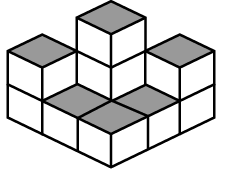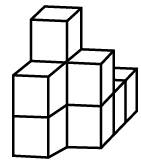Class 5 Maths Chapter 14 Important Question Answers - Chapter 14 - How Big How Heavy
Q1: Find the number of cubes in the base layer of the following figure:
Ans: The number of cubes in the base layer of the given figure = 6
Q2: Count the number of cubes in the given shape
Ans: Total cubes in given figure are :11
Q3: Count the number of cubes in the given shape
Ans: Total cubes in given figure are: 9
Q4: Count the number of cubes in the given shape.
Ans: Total cubes in given figure are :110
Q5: Count the number of cubes in the given shape
Ans: Total cubes in given figure are :113
Q6: Solid spheres of diameter 6 cm are dropped into a cylindrical beaker containing some water and are fully submerged. If the diameter of the beaker is 18cm and the water rises by 40cm, find the number of solid spheres dropped in the water.
Ans: By volume conservation we can say that the amount of water displaced by solid sphere is equal to the volume of spheres being dropped inside the cylindrical beaker. where x is the number of spheres
where x is the number of spheres where r = 3 and R = 9
where r = 3 and R = 9
On solving,
x = 90
Q7: How many lead cubes of side 2 cm could be made from a lead cube of side 8 cm?
Ans: Let x be the number of lead cubes of side 2 cm
Since all the smaller lead cubes are formed from the bigger lead cube of side 8 cm
⟹ Number of smaller lead cubes × volume of each lead cube = volume of bigger lead cube
⟹ x × (2)3 = (8)3 [∵ Volume of cube of edge length a is a3]
⟹x = 64
∴ 64 smaller lead cubes can be made form the bigger lead cube
Q8: Count the number of cubes and find the volume in cu. cm.
(Let the side of each cube = a)
Ans: We observe that the number of cubes present = 10
Given: Side of each cube = a
Total volume = 10 × a3
=10a3
Q9: Count the number of cubes in the given shape
Ans: Total cubes in given figure are :10
Q10: Metal spheres, each of radius 2 cm, are packed into a rectangular box of internal dimensions 16cm × 8cm × 8cm. When 16 spheres are packed the box is filled with preservative liquid. Find the volume of this liquid (in cm3). Give your answer to the nearest integer. [Use π = 3.14]
Ans: Volume of rectangular box = lbh = 16 (64) = 1024 cm3
Volume of sphere = 4/3 πr3 = 33.5238 cm3
16 sphere = 16 (33.5238) = 536.3808
Volume of liquid = 1024 − 536.3808 = 488 cm3
|
28 videos|169 docs|41 tests
|
FAQs on Class 5 Maths Chapter 14 Important Question Answers - Chapter 14 - How Big How Heavy
| 1. How big is a Class 5 vehicle and what are its weight limitations? |  |
| 2. What are the common uses for Class 5 trucks? |  |
| 3. Can a regular driver's license be used to operate a Class 5 vehicle? |  |
| 4. What are the advantages of Class 5 trucks over other classes? |  |
| 5. Are there any specific safety regulations or requirements for Class 5 vehicles? |  |

|
Explore Courses for Class 5 exam
|

|
















